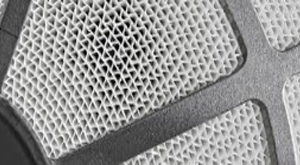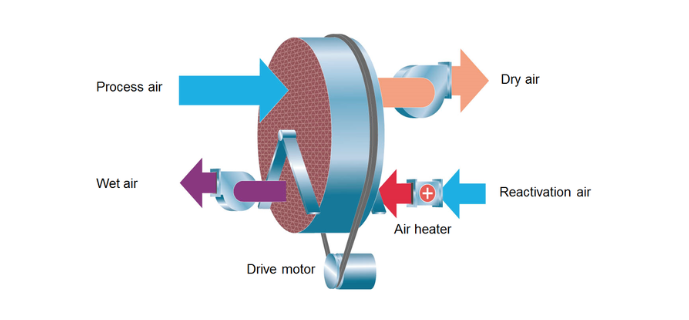In Part 1, The Science Behind Desiccants, of this series, we learned that silica gel is a good desiccant because it has a large capacity to adsorb moisture and that it can be regenerated by using heat to remove the moisture. In Part 2, I’ll explain how a desiccant dehumidifier is designed to best utilize these properties of a silica gel rotor.
Evolution of Silica Gel as a Desiccant
The discovery of silica gel dates back to the 1600’s, but initially it was considered only a scientific curiosity. The first large scale use of silica gel was in World War I as an adsorbent in gas mask canisters. Because of the high demand for the war, a professor from John Hopkins University developed the process to synthetically manufacture silica gel in 1919.
One of the first uses of silica gel as a desiccant was by the US military during WWII to keep supplies dry during transportation. After WWII, one of the first commercial uses of silica gel was by museums to protect high priced art during transportation. But silica gel still was not widely used as a desiccant because it was financially impractical to regenerate.
It wasn’t until the late 1950’s that the first commercial dehumidifier was manufactured using a silica gel rotor. The silica gel rotor was the breakthrough development that made it possible to have silica gel adsorb moisture and regenerate in one continuous process.
Silica Gel Rotor
 The silica gel rotor is now the heart of most desiccant dehumidifiers. The core of the rotor is made of a corrugated material that is then impregnated with silica gel on all surfaces. The benefit of using a corrugated material is twofold. First, the corrugation provides a large surface area for maximum air exposure to silica gel. Second, it allows air to pass through with only a small pressure drop. That second benefit is very important because the rotor thickness determines how much moisture is removed as the air passes through. Thicker rotors are used when a very low relative humidity is desired in the conditioned space.
The silica gel rotor is now the heart of most desiccant dehumidifiers. The core of the rotor is made of a corrugated material that is then impregnated with silica gel on all surfaces. The benefit of using a corrugated material is twofold. First, the corrugation provides a large surface area for maximum air exposure to silica gel. Second, it allows air to pass through with only a small pressure drop. That second benefit is very important because the rotor thickness determines how much moisture is removed as the air passes through. Thicker rotors are used when a very low relative humidity is desired in the conditioned space.
One Continuous Process, Two Separate Air Streams
The one continuous process to adsorb moisture and regenerate the silica gel involves two separate air streams. The stream of air from which we want to remove moisture is referred to as the process air stream. It enters the silica gel rotor from one side laden with moisture then exits the other side as dry air. The process air stream is supplied from and exhausted to a space that we want to condition with dehumidified air.
The stream of air used to regenerate the silica gel is referred to as the reactivation air stream. The reactivation air is heated to 230ºF before entering the rotor. As the reactivation air passes through the rotor, the heat breaks the chemical bond between water and silica gel. The reactivation air then exits the rotor carrying away the moisture. Reactivation air is supplied from and exhausted to an area that is outside the space that is to be conditioned with dry air.

The picture above shows how these two air streams are separated into two zones as they pass in opposite direction so that they don’t mix. As the rotor turns at a very low speed, the process air flows through the largest portion of the wheel and deposits the moisture. As the portion of the wheel that was exposed to process air stream rotates in the reactivation air zone, the moisture is removed. After it has been dried, that portion of the wheel that was in the reactivation zone rotates back into the process air zone ready to adsorb moisture again.
Post-Cooling
The one drawback to the reactivation portion of the process is that some of the heat used to separate the water from the silica gel is retained by the silica gel. As the heated portion of the rotor enters the process air zone, the heat is transferred to the process air. The result is that the process air stream temperature can increase by as much as 50ºF. When it is not desirable for heated process air stream to be returned to the conditioned space, a cooling coil is added to remove the heat. This is referred to as post-cooling because the cooling occurs after the process air has gone through the rotor.
Pre-Cooling
When an application requires very dry air and the practical thickness of the rotor has been maximized, a cooling coil is added to the process air stream before it enters the rotor. The pre-cooling coil will remove some of the moisture from the process air before it enters the rotor. That allows the silica gel rotor to then take the moisture content of the process air down to the very level required for the application.
Recap
In Part 2 of the series on Desiccant Dehumidifiers, we learned that the development of the silica gel rotor in the 1950’s is what allows for one continuous process of adsorption and regeneration used in today’s desiccant dehumidifiers. We also learned that the one continuous process requires two separate air streams: the process air stream and the reactivation air stream. Finally, we learned that some desiccant dehumidifier application may require the addition of either pre or post cooling coils to the process air stream
In the third and final part of this series, I will present example applications where a desiccant dehumidifier solves the need for dry air.
